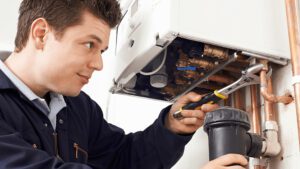Winter can be tough on properties, and it’s important to take the necessary steps to protect them during the colder months. However, when spring arrives, it’s time to de-winterize the property to ensure everything is in good working order. Below are the steps to follow when de-winterizing a property.
Step 1: Confirm Utilities Are On
The first step is to confirm that the utilities are on. If they are not, you need to contact the appropriate party to have them turned on before starting the de-winterization process. Once utilities are on, close off faucets and fix shut-off valves, including the hot water tank drain. A system pressure test at 35 psi for 30 minutes is essential, and if the test fails, locate and repair the damage for the allowable. If there is no allowable or repairs cannot be completed for the allowable, provide a detailed bid for the repairs.
Step 2: Check the Heating System
Before turning off the heating system for the season, ensure it’s in good working order. Visually inspect the system for missing parts or obvious signs of damage. If there are no obvious signs of damage, you can de-winterize the heating system. For a dry heat system, turn on any breakers to the furnace and ignite the pilot light. If the system is gas-fed, check to ensure it’s functioning properly and will continue to function once unattended. The thermostat needs to be set to 55 degrees on a wet heating system. Visually inspect the system for missing parts or obvious signs of damage, and ensure all bleeder valves on the radiators are in the closed position.
Step 3: De-Winterize Domestic Water System
The next step is to start de-winterizing the domestic water system. Open up all faucets and fixtures shut-offs one at a time, starting with the furthest fixture from the main shutoff. Ensure all air is bled from the system and close each faucet before opening the next one. Let the system run and continuously check for leaks. Remove all toilet wraps and flush out the antifreeze from all toilets and drain traps. Wait 30 minutes before leaving the property to ensure there are no leaks, and visually check for leaks on all floors throughout the house. Verify that the hot water tank is full by depressing the pressure release. If the tank is not full, wait for it to become full. Turn on the hot water tank by turning on the electric breaker and then igniting the pilot light if it is gas-fed.
Step 4: Remove Winterization Stickers and Debris
After completing all the steps, remove all winterization stickers and any residue left behind from the stickers. Also, take any debris that was created from the de-winterization with you.
De-winterizing a property is an important process that ensures the safe and efficient use of the property during the non-winter months. By following the steps outlined above and documenting each stage of the process, property owners can ensure their property is properly prepared for use in the warmer months. Always check for leaks and damage and repair them if necessary. By taking the time to properly de-winterize the property, occupants can enjoy a worry-free and comfortable living space throughout the year.
